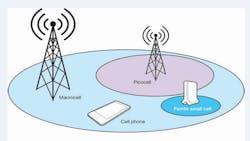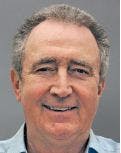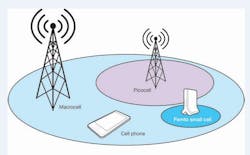HetNet Solutions Advance While Femtocell Transceivers Cut Design Costs
Increased coverage and operating capacity are sorely needed if future cellular networks are to provide adequate service. With more than one billion mobile-broadband users worldwide, heterogeneous-network (HetNet) technology is progressing rapidly to meet that goal. HetNet will provide substantial numbers of macro-networks and a large number of small cells, including femtocells. In the past, large cells encountered problems when they handled large numbers of users, which reduced the operating capacity per customer. Instead, HetNets will provide smaller, diversified cells as well as the intelligence needed to manage capacity and integrate large numbers of small cells.
According to the firm, for example, the MAX2550–MAX2553 single-chip, small-cell radio transceivers can improve both residential coverage and network capacity. The MAX5879 direct RF-synthesis DAC targets multicarrier, multiband, and multi-standard macrocell, small-cell, and wireless-backhaul transmitters. The MAX2870 ultra-wideband, 23.5-to-6000-MHz synthesizer with an integrated voltage-controlled oscillator (VCO) enables multiband local-oscillator (LO) frequency synthesis in base-station radios. Maxim also introduced the MAX15301 InTune digital point-of-load controller and the MAX2612–MAX2616 broadband, 40-to-4000-MHz gain blocks.
HetNet solutions, which are designed for next-generation base-station equipment, include single-chip multiband radio transceivers, broadband gain blocks, direct RF-synthesis DACs, and intelligent digital point-of-load controllers.
Maxim has also developed an RF DAC that can reportedly enable a digital transmitter solution supporting standards ranging from second- to fourth-generation (2G to 4G). The MAX5879 multi-Nyquist RF DAC creates a common hardware platform for multi-carrier, multi-band, and multi-standard base stations. Working with field-programmable-gate-array (FPGA) -based direct digital synthesis (DDS), the DAC makes it possible to implement traditional analog functions, such as the quadrature modulator and agile LO, in digital form. According to the company, this approach will eliminate in-phase and quadrature errors as well as the LO feedthrough often associated with
analog conversion.
The MAX5879’s selectable-frequency-response modes support direct RF synthesis of common 3G/4G cellular bands in multiple Nyquist zones from 700 MHz to 2.8 GHz. A single MAX5879 RF DAC serves multiple standards, such as multicarrier GSM, WCDMA, and LTE.
Transceivers Can Cut System Costs
As part of the HetNet trend, femtocells in particular are increasingly being used to supplement base-station cell sites—especially those that are already operating at maximum capacity. Carriers also are moving to home- and office-located femtocell transceivers that provide a localized base station to handle cellular voice and data needs. To answer the call for femtocells, Maxim has developed femtocell transceivers that support WCDMA (Bands 1 to 6 and 8 to 10) and cdma2000 (Band Class
0, 1, and 10).
To help service providers achieve more compact, lower-cost radio designs, the MAX2550–MAX2553 transceivers work with minimal external components. According to the firm, they also will reduce operation and maintenance costs and help with the creation of more compact radio designs for modules and standalone femtocell applications. Such compact radios are essential, given the higher installation and maintenance costs associated with existing large macrocells. In some areas, carriers are struggling with space limitations and city regulations when planning to create more macrocell base stations.
About the Author
Paul Whytock
Editor-in-Chief
Paul Whytock is European Editor for Microwaves & RF and European Editor-in-Chief for Electronic Design. He reports on the latest news and technology developments in Europe for his US readers while providing his European engineering audience with global news coverage from the electronics sector. Trained originally as a design engineer with Ford Motor Co., Whytock holds an HNC in mechanical, electrical, and production engineering.


